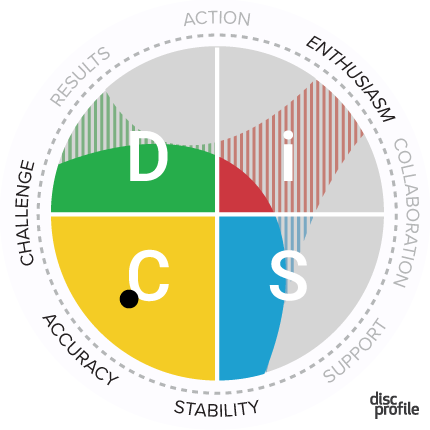The Everything DiSC® Manual is a comprehensive guide and an essential reference tool for anyone interested in learning more about the research that supports Everything DiSC. We thought we’d share some of what we have highlighted in our copies.
Styles
Definition
“A style is a set of typical response patterns that are expected from a person. However, that doesn’t mean that a person can only exhibit that pattern. For instance, an individual who has been assessed and located in the D quadrant will demonstrate more dominant behaviors and preferences than the average person, but will also, from time to time, show behaviors and preferences that are associated with the other three quadrants.”
Style preferences are equally distributed among the population
“The standardization of the eight scales ensured that the assignment of DiSC styles was roughly equal across the twelve styles. The Everything DiSC assessment has been translated into other languages where local norm groups are used to establish the optimal items and norms for each scale.”
Dot placement
The dot is seldom in the center
“A sample of 26,703 respondents was evaluated to estimate the distribution of DiSC inclinations in the population. … [M]ost respondents’ dots (81.8%) were located in the outer half of the circle.”
Priority scales
Priorities are only part of the measurement of style
“The priority scales measure much more narrow constructs. For instance, the i DiSC scales measures a sociable, lively disposition. The priority scale of Enthusiasm measures only liveliness. These more narrow scales are used to interpret the respondent’s results within a context that is most relevant to the respondent.”
You can see below that the priority for the S is Inclusive when measured for the Work of Leaders profile and Receptive when measured for the Agile EQ profile. The focus and context of the profile will determine what’s measured by the priority scale.


Multiple priorities are possible (see the Workplace example below).
“In a sample of 57,648 respondents across all applications, a total of 32.5% of respondents received extra priorities. Within this group, 29.2% received one extra priority and 3.4% received two. No participants had three or more priority scale scores above the threshold.”

Agreement with self-descriptions
People agree with the narrative descriptions of their styles
“Overall, participants report that the DiSC fit is good or excellent approximately 90% of the time. As documented under the Forer effect (1949), however, it is not unusual for participants to show a high level of agreement with psychological test results, especially when those results include broad interpretations that could accurately describe most individuals in the population.”
Observers also show agreement
“… a study was conducted to examine the relationship between DiSC assessment results and observer ratings of leadership behavior. … The results of the analysis were largely as expected under the theoretical DiSC model. For 71% of the [leadership] practices, the expected style had the highest mean. For 88% of the practices, the expected style was among the top two highest means.”
Appropriate populations
Age
“The Everything DiSC assessment has been developed and validated on adults 18 years or older and is appropriate for this population. It is a nonclinical assessment, designed to support personal development and professional relationship in a work setting.”
Reading skill level
There is no time limit for completing the questionnaire, “making it possible for people requiring more time to complete the assessment without need of any special adaption or modification.”
Flesch Reading Ease score: 74.2
Flesch-Kincaid Grade Level: 4.7
Correlation with occupations
DiSC should not be used to judge career compatibility
“An analysis was performed to examine the relationship between DiSC scale scores and occupational membership. … Overall, these results suggest that DiSC does have a relationship to occupational membership for selected occupations, but as expected, this relationship is modest.”
Stability
If you take a DiSC assessment today and again in a year, your results should be very similar.
“Stability refers to the assessment’s ability to yield the same measurements over a period of time. … A sample of 599 respondents took the DiSC assessment twice with a two-week interval between testings. … [D]ata suggests that the DiSC scales are stable over repeated administration. Consequently, test takers and test administrators should, on average, expect no more than small changes when the instrument is taken at different times. As the period between administrations increases, however, the divergent results of these administrations will become more and more noticeable.”
Demographic differences
Gender
“These differences are generally small. The largest differences are seen on the iS scale, in which gender accounted for 3.7% of scale variance. Women tended to score higher on the i, iS, S, and SC scales, and men tended to score higher on the D, Di, C, and CD scales.”
Heritage
“These differences are generally small. The largest differences are seen on the CD scale, in which heritage accounted for 2.5% of scale variance.”
Education
“These differences are generally very small. The largest differences are seen on the Di scale, in which education accounted for 0.7% of scale variance.”
Ethnicity
“Practically speaking, knowing someone’s ethnic background will tell a practitioner almost nothing about that person’s DiSC style.”
More to learn
Selected pages from the book
The Myers-Briggs Type Indicator (PDF)
Distribution of Inclination by Gender and Heritage (PDF)
Appendix A: DiSC History (PDF)
The Manual is full of additional information. Trainers and coaches who use DiSC will be interested in the section titled “Interpretation of Results” and in the chapters that focus on specific profiles.
If you love data, you’ll love this book.

